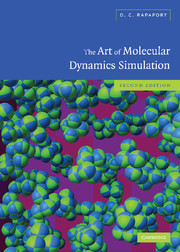Book contents
- Frontmatter
- Contents
- Preface to the first edition
- Preface to the second edition
- About the software
- 1 Introduction
- 2 Basic molecular dynamics
- 3 Simulating simple systems
- 4 Equilibrium properties of simple fluids
- 5 Dynamical properties of simple fluids
- 6 Alternative ensembles
- 7 Nonequilibrium dynamics
- 8 Rigid molecules
- 9 Flexible molecules
- 10 Geometrically constrained molecules
- 11 Internal coordinates
- 12 Many-body interactions
- 13 Long-range interactions
- 14 Step potentials
- 15 Time-dependent phenomena
- 16 Granular dynamics
- 17 Algorithms for supercomputers
- 18 More about software
- 19 The future
- Appendix
- References
- Function index
- Index
- Colophon
2 - Basic molecular dynamics
Published online by Cambridge University Press: 28 February 2011
- Frontmatter
- Contents
- Preface to the first edition
- Preface to the second edition
- About the software
- 1 Introduction
- 2 Basic molecular dynamics
- 3 Simulating simple systems
- 4 Equilibrium properties of simple fluids
- 5 Dynamical properties of simple fluids
- 6 Alternative ensembles
- 7 Nonequilibrium dynamics
- 8 Rigid molecules
- 9 Flexible molecules
- 10 Geometrically constrained molecules
- 11 Internal coordinates
- 12 Many-body interactions
- 13 Long-range interactions
- 14 Step potentials
- 15 Time-dependent phenomena
- 16 Granular dynamics
- 17 Algorithms for supercomputers
- 18 More about software
- 19 The future
- Appendix
- References
- Function index
- Index
- Colophon
Summary
Introduction
This chapter provides the introductory appetizer and aims to leave the reader new to MD with a feeling for what the subject is all about. Later chapters will address the techniques in detail; here the goal is to demonstrate a working example with a minimum of fuss and so convince the beginner that MD is not only straightforward but also that it works successfully. Of course, the technique for evaluating the forces discussed here is not particularly efficient from a computational point of view and the model is about the simplest there is. Such matters will be rectified later. The general program organization and stylistic conventions used in case studies throughout the book are also introduced.
Soft-disk fluid
Interactions and equations of motion
The most rudimentary microscopic model for a substance capable of existing in any of the three most familiar states of matter – solid, liquid and gas – is based on spherical particles that interact with one another; in the interest of brevity such particles will be referred to as atoms (albeit without hint of their quantum origins). The interactions, again at the simplest level, occur between pairs of atoms and are responsible for providing the two principal features of an interatomic force. The first is a resistance to compression, hence the interaction repels at close range. The second is to bind the atoms together in the solid and liquid states, and for this the atoms must attract each other over a range of separations.
Information
- Type
- Chapter
- Information
- The Art of Molecular Dynamics Simulation , pp. 11 - 43Publisher: Cambridge University PressPrint publication year: 2004
Accessibility standard: Unknown
Why this information is here
This section outlines the accessibility features of this content - including support for screen readers, full keyboard navigation and high-contrast display options. This may not be relevant for you.Accessibility Information
- 9
- Cited by
